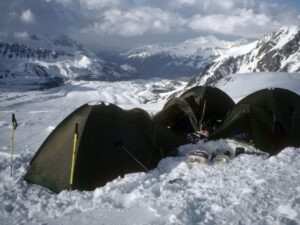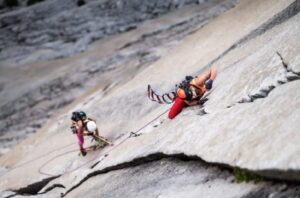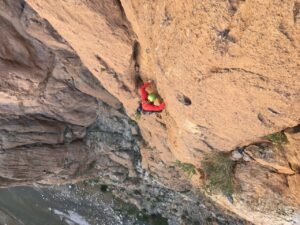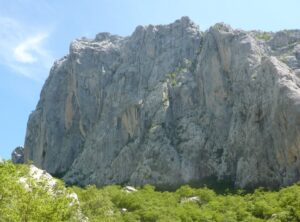Climbing, paddling, hiking, running, swimming: Five epic long-distance adventures in New Zealand, and what it takes to complete them.
Kiwi culture is about embracing the great outdoors. With more than 3,000 glaciers, 100 mountains, and national parks covering 11 percent of the country, it’s easy to see what the lure is. Although a relatively small country, New Zealand has been the scene of some epic long-distance adventures. Here are the five hardest.

Te Araroa Trail
Running the length of New Zealand
This is one of the few ultra-distance land routes in this relatively compact country. In 2011, the 3,000km Te Araroa Trail opened along New Zealand’s innermost spine.
Unlike tramping tracks, this trail isn’t entirely marked. It passes scenic volcanoes and open beaches. It crosses private farmland, enters small towns, large cities, and requires a ferry crossing between North and South Islands.
Despite its brushes with civilization, the trail shouldn’t be underestimated. An unforgiving high-country climate makes the Tararua Ranges one of the toughest parts of the trail. Elsewhere, the intense sun can easily dehydrate. In some areas, the trail crosses rivers up to three kilometres wide.
It didn’t take long for adventurers to set personal challenges on the Te Araroa Trail. The year after it opened, Richard Bowles ran it in 62 days. He averaged 50km a day. This included several tumbles down steep mountains and knee-deep mud wading.
But Bowles was experienced for the task: He’d already run the world’s longest marked trail, the National Trail of Australia. He also spent almost half a year running the equivalent of 127 marathons from Melbourne to Cooktown, Australia.
Since Bowles, plenty of others have set out to best his time. In 2020, George Henderson surpassed him with the fastest time of 49 days, 14 hours 26 minutes. Local runners joined him along the trail, and his Mum and Dad followed in their campervan for moral support.
Henderson says that the final 300km through Southland were the toughest. Trails were slow, and he was mentally and physically exhausted. He wore through six pairs of shoes during the run.
Fastest woman
Brooke Thomas, who broke the women’s fastest time earlier this year, also wore through six pairs of shoes. She gave up a rowing career 10 years earlier when she was fitted with a pacemaker. Eight broken bones in the intervening years delayed her opportunity to give Te Araroa a chance. She completed it in 57 days, 12 hours 16 minutes.
“It’s not an easy running track. There are times when you’re right out in the challenging high country and it’s very remote and you spend a lot of time on your own,” said Thomas.
In 2019, nine-year-old Elizabeth and seven-year-old Jonathan Rapsey became the youngest kids to walk the trail. Elizabeth even carried her own pack, “to slow her down”, her mum said. It took them and their parents six months to complete.

Meda McKenzie swims the Cook Strait in 1984. Photo: The Spinoff
Cook Strait double swim crossing
Between New Zealand’s North and South Island is one of the most challenging stretches of water in the world. The Cook Strait connects the Tasman Sea with the South Pacific Ocean. The distance is only 22km across the narrowest points, but strong cross-currents make it further when swimming.
In 1962, Barrie Devenport became the first person to swim the Cook Strait. It took him 11 hours 20 minutes to complete. Since then, countless swimmers have taken the challenge but only two have dared a double-crossing.
Philip Rush first swam from South Island to North Island and back again in 1984. It took him 16 hours 16 minutes to complete. He repeated his effort four years later. This time, it took Rush almost two hours more to swim the same distance.
“It is a bit frightening when swimming Cook Strait in the middle of the night”, said Rush. “It’s pitch black. You have a big boat in front of you and two small IRBs [inflatable rescue boats] beside you. You can’t see anything.”
Rush also holds the record for fastest two-way and three-way swim of the English Channel.
A defiant double
Inadvertently, Rush also spurred on a defiant 21-year-old mother of two, Meda McKenzie, by suggesting that no woman would be able to do a double-crossing for at least a decade after he did.
McKenzie had already swum the Cook Strait one-way in 1978. She actually swam the one-way twice that year. Then twice in 1984. Her third time that year was a double-crossing which took her 23 hours 6 minutes.
“On my first Cook Strait swim, I saw someone [support crew] with a shotgun pointing over me. They said, ‘There might be a shark.’ That was a little bit scary,” said McKenzie.
Still the only woman to swim a double-crossing of the Cook Strait, McKenzie claims that she’s not a particularly strong swimmer, she’s just very stubborn.
The Cook Strait is one of the events in Oceans Seven, a list of seven difficult channel swims. It includes the Strait of Gibraltar and the Kaiwi Channel.
The youngest person ever to swim the Cook Strait is 12-year-old Caitlin O’Reilly.

Don French. Photo: 100 Great Peaks NZ Facebook
100 Peaks Challenge
In 1991, the New Zealand Alpine Club (NZAC) celebrated its centenary by setting a new challenge. Designed to encourage climbers of all abilities to get off the beaten track, the 100 Peaks Challenge features a mixture of easy, extremely difficult, and wildly remote peaks.
“We want to capture the imagination of NZAC members,” the club wrote. “Selection of the 100 peaks has aimed to provide a wide spread of peaks both geographically and in difficulty so that there is a challenge for every club member.”
The first person completed the 100 Peaks Challenge only this year. Don French, now 62, took 30 years to work through the list. His final mountain was Mt. Unicorn in the Southern Alps. It has 26 pitches and is likely the longest rock climb in the country.
Once he reached the top of Mt. Unicorn, French allowed himself a moment to enjoy the glory.
“But when you’re on top of a mountain, you’ve only done half the job,” he said. “Getting down is the other, so you have to remain focused on the job and not let yourself get too carried away with the situation.”
One of the most challenging aspects of the 100 Peaks Challenge is that 95 of the climbs are on the larger but sparsely settled South Island. And the geographical spread of the 100 makes it tough to knock off a few over a weekend.
Currently, about 70 people are working on the list, but the next closest to French has 90 (!) left to climb.
Of those on the list, Jagged Peak in the Arrowsmith Range is one of the most challenging ice routes in the country. Aoraki, or Mt. Cook, is the tallest peak (3,724m). Fiordland’s Mitre Peak (1,692m) is one of New Zealand’s most photographed peaks.

Paul Caffyn during his historic Australia circumnavigation. Earlier, he became the first person to circumnavigate New Zealand. Photo: Paulcaffyn.com
Circumnavigation by kayak
New Zealand might be small, but its coastlines are rugged and oceans unforgiving. On the South Island’s West Coast, wild surf requires good technical paddling. Then there are the sharks. New Zealand’s oceans abound in great whites.
In 1979, legendary kayaker Paul Caffyn became the first person to paddle completely around New Zealand.
He and a friend, Max Reynolds, initially spent 27 days paddling partway around the South Island in 1977. When Reynolds pulled out, Caffyn continued alone for the remaining 49 days. The following year, he spent 86 days paddling solo around the North Island. He was on the water for 63 of those. Finally, he and Reynolds again teamed up for the Stewart Island section.
The southwest corner of New Zealand was particularly gnarly. There, Caffyn survived “capsizes in surf at night, some huge swell days, not to mention the sandflies”.
This was the first of Caffyn’s kayaking achievements. Later, he circumnavigated Britain and then made history circumnavigating Australia.
It wasn’t until 2014 that the first woman circumnavigated New Zealand. Tara Mulvany spent five months first circumnavigating the South Island. She then took almost four months to complete the North Island. Stewart Island was next: That took her five weeks.
Over the grueling 10-month expedition, Mulvany credits the South Island for teaching her the necessary technical surf paddling skills to help her through the rest of the expedition. She put her skills to use during a particularly horrendous Stewart Island section. Deteriorating weather forced her back to where she started, after paddling for nine hours.
“It was one of those days when I didn’t care that I’d gotten nowhere,” she says. “I was thankful just to be on land.”

Brando Yelavich is the only person to walk New Zealand’s entire coastline. Photo: @Brandoyelavichexplorer
Walking New Zealand’s entire coastline
Only one person has walked New Zealand’s entire coastline. Sheer cliff faces, harsh climates, and uncompromising gorse make trekking nearly impossible. There’s also private land, some of which is sacred to Maori, that walkers must contend with.
In 2015, Brando Yelavich was just 19. Facing relentless depression, wondering which direction to steer his life, he stuffed a 50kg backpack with food and gear and started walking. He expected to be trekking for eight months. Instead, it ended up as a 600-day journey of self-discovery. In the process, he became the first person to walk the entire coastline of New Zealand.
He began his 8,700km adventure in Cape Reinga, New Zealand’s northernmost tip. Those first few days became a crash course in outdoor stoicism. Yelavich suffered crippling leg cramps, could barely see more than 20m in front of him because of bad weather, and had to contend with hundreds of mosquitoes. But he wasn’t about to give up.
“[Every day] I’ll probably raft across three different rivers,” he said. “When I started, I would build all my rafts out of driftwood…And I’d paddle across. Now I’ve got a [pack]raft, so that’s a lot easier, and not as dangerous. But I’ve had to teach myself how to abseil without a harness and still be able to retrieve my rope.
Yelavich walked, swam, climbed, and packrafted. He’d never lived in the wild before. Yet armed with a copy of A Field Guide to the Native Edible Plants of New Zealand, he lived off the land by hunting and gathering.
Several times he almost drowned. He fell off cliffs and faced near hypothermia. “Each near-death experience has made me appreciate something in a new way,” he says.






